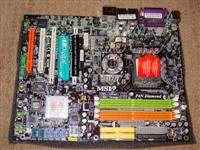Layout and Features
|
MSI's strategy in regard to layout and color scheme with the P4N Diamond tie together perfectly. With some other boards, there's little rhyme or reason when it comes to putting all of the pieces together. One look at the P4N Diamond, and you can see otherwise. The board itself is dark; possibly a dark brown mixed with black. Major slots or ports, however, are brightly colored, which allows the builder to quickly find the slot they're looking for. Anyone who works in low-light conditions can appreciate the neon-like colors that are used for the DIMM slots, IDE ports, and to a lesser degree, the six SATA ports along the front of the board. Even the pins for the front panel are color coded, which means no more hunting down a manual when it's time to re-build. One issue we did have with the color scheme, however, was with the DIMM slots. Usually, when using dual channel memory, it's more convenient to have both slots for one channel in one color, to help signify where the RAM should be correctly placed. MSI's take is to have the channels colored together, so that Channel A is Green and Channel B is Orange. Thus, one installs a DIMM into a Green and an Orange slot to propagate both channels.
There's nothing overly fancy when it comes to cooling down the North and South bridges. A smaller, actively cooled heatsink with fan was placed on the NorthBridge, while a larger, passive heatsink sat atop the SouthBridge. To allow for better heat absorption, this heatsink has a copper core with aluminum fins, but we noticed that it was still running quite hot during our testing. It's nothing like the heatpipes that we've seen lately or like advanced cooling techniques on other boards. Still, proper placement of case fans and clean cabling techniques can keep the board running cool and stable, and the methods MSI employs add little to overall noise output.
Although the layout of the board seems optimal, the lower left edge of the board is particularly crowded with connectors and other motherboard devices. Sitting close to the SouthBridge are all six SATA ports, as well as the front panel pins, and three USB 2.0 connectors which can be used for front panel access. Nestled in the same area are the MSI Core Cell and AMIBIOS chips, as well as the VIA VT6306 FireWire controller. Just about the only chip not found here is the Creative SoundBlaster Live 24-bit on-board audio, which is found on the other side of the board, between the PCI slots and the chassis. One last addition, which is easy to overlook, is a small red button that's used to clear the CMOS should any problems occur that prevent normal booting.
Of course, no review of an nForce4-SLI board would be complete without taking a look at the layout of the PCI and PCI Express slots. Clearly advertised by the blue sticker placed between the x16 slots, the P4N Diamond was one of the first boards to use what MSI calls a Digital SLI Switch. This basically means that the board automatically detects when a second graphics card has been added, and allocate 8 lanes for each. No slots come between the two PCI-e x16 slots, preventing any conflicts with larger heatsinks that come on some of the 7800GTX models. A single PCI-e x1 slot is placed to the right of the primary x16 slot, directly adjacent to a 4-pin MOLEX power connector. On the other side are two standard PCI slots, one in white and the other colored orange. The orange slot is colored so, as it can be used to install a communications card as well as standard third-party PCI cards.


















